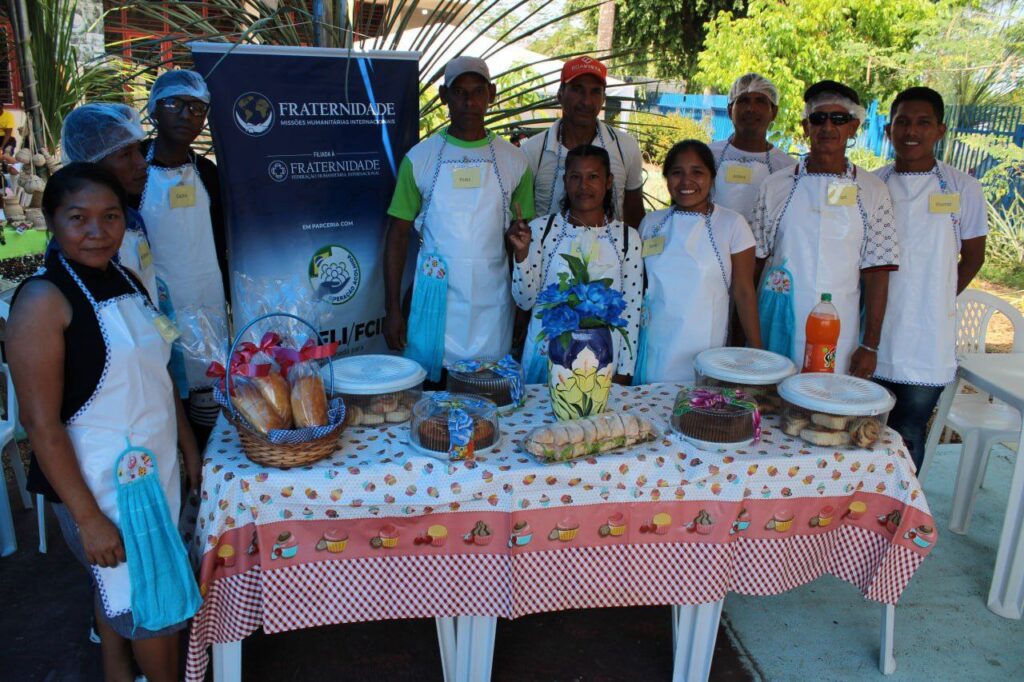The Fraternity – International Humanitarian Missions (FIHM), through the Roraima Humanitarian Mission, has been promoting fairs at the Indigenous Cultural and Training Centre (CCFI), in Boa Vista – RR, open to the general public. In total, nine intercultural fairs have taken place since 2021, when this activity began, which, throughout this period, has been evolving and bearing fruit.
Regarding the task undertaken at CCFI, Friar Thomas, a volunteer humanitarian actor at the Fraternity – Humanitarian Missions (FIHM), explained that “the indigenous intercultural fair represents an important moment in the organization’s work with the indigenous refugee and migrant population; it represents the meeting of entrepreneurs within their creativity, within their search for autonomy. And, over time, the fair has become stronger; the integration itself and the work with the indigenous people set the tone.”

Regarding the evolution that has been observed in the task of fairs, Friar Thomas highlighted the penultimate one, which took place on August 29th: “Today, we have the themed fair, which we didn’t have before, as well as food spaces and a very large participation of entrepreneurs, who are now more than 80 taking part in the fair.”
According to Ricardo Treno, volunteer humanitarian actor and operational coordinator at CCFI, “the fair represents hope for migrants who arrive in Brazil in search of rebuilding their lives.” He recalled that “every day, we have new Venezuelan migrants arriving in Brazil and this situation and difficulty can be transformed into an opportunity.”


Regarding what is expected from the fairs, Juan Diego, volunteer humanitarian actor at the Fraternity – Humanitarian Missions (FIHM), shared: “We consider the fair to be an opportunity for indigenous peoples to meet, which is why it is called intercultural, that is, an encounter between cultures. Fourteen ethnic groups were present at the last fair – from Venezuela, Guyana and Brazil – and they are naturally exchanging experiences. We create an environment with the attractions, and the idea is that even the attractions are indigenous (screen printing, lectures, musical performances, dance, crafts and typical food), so that they can see themselves in the attractions of other ethnicities.”
In this sense, Fabíola, an indigenous Venezuelan artisan from the Warao ethnic group, expressed: “I feel very proud to meet a new family within this small meeting, where we get to know the work of other ethnicities and feel like brothers and sisters, sharing our culture and recognizing this value, the intelligence of each person, of each ethnic group.”


From an economic and financial point of view, the fair allows refugee migrants to obtain income through the sale of handicrafts. Therefore, it represents one of the stages of the lasting solution, which allows integration with local society in order to sell the products they produce throughout the months and year. The mission supports the production of products at various times, from the harvesting of buriti, the raw material used, to the dissemination and sale of the handicrafts made in the city of Boa Vista.
Ricardo informed that “several of them have different techniques for working with buriti and crafts. They share these different forms with each other, and there is a cultural enrichment of the techniques that guarantee their survival.”
“I think these events are very important for us to value indigenous culture. We know that we often don’t value it as much as we should and I’m loving it, there’s a lot of variety, a lot of products,” shared Verônica, a visitor to the fair.


From the point of view of the importance of valuing the identity of indigenous peoples and the cultural richness that these peoples bring, not only to Brazil, as a root people, but to everyone, sister Maria Raquel, coordinator of the Roraima Humanitarian Mission, reflected that “this culture is alive, this ancestry is alive; they bring this and it is seen at the fair and in the different moments in which we can exchange our own expression with them.”
About this, Laís, a visitor to the intercultural fair, said that “people have shown their art, they have revealed their potential and we have really appreciated what comes from indigenous culture, both in Brazil and Venezuela, and it is all very beautiful.”
Sister Maria Raquel adds that “the fairs are strategic, because they bring the outside public closer to Boa Vista to get to know all this legacy, so that the society of Boa Vista can come and get to know all this ancestral knowledge, all this disposition of Venezuelan indigenous migration.”


The opportunity for cultural strengthening brought by the fairs allows that the history and identity of migrants are not lost in the challenges they experience. According to philosopher José Ortega, “…culture is a constitutive dimension of human existence, just as hands are an attribute of man.”
In an attempt to translate the grandeur of the cultural task that fairs bring, Ricardo concluded that the event represents “a great convergence of people, cultures, knowledge; several hearts, several stories, several opinions, several futures, several intersecting hopes and dreams…”
Friar Thomas sums it up by saying that this action “is a drop, but it is a drop that increasingly becomes bigger, more effective, and we believe that this has an impact.”






